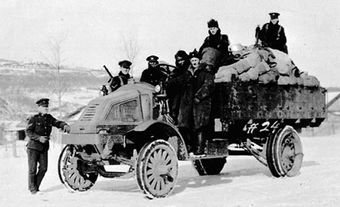The Mackenzie-Papineau Battalion was a battalion of Canadians that fought against fascist forces in the Spanish Civil War (1936–39). It is also a collective name for more than 1,500 Canadian volunteers who served in the conflict, either with the “Mac-Paps” or in other units.

Spanish Civil War
The Spanish Civil War (17 July 1936–1 April 1939) was fought between the left-leaning Republican government of Spain and the conservative Nationalists, led by General Francisco Franco. Both sides turned to other countries for help. Germany and Italy, then under fascist leaders Adolf Hitler and Benito Mussolini, contributed planes, tanks and soldiers to the Nationalist cause while the Soviet Union sent supplies to the Republican forces. Although many countries signed a nonintervention pact in 1936, approximately 40,000 foreign volunteers served in international brigades on the Republican side, while another 20,000 served in medical and auxiliary units.

Canadian Involvement in the Spanish Civil War
Like most other countries, Canada decided not to become officially involved in the Spanish Civil War. However, many Canadians closely followed the conflict in newspapers and other publications, and some fundraised for the Republican cause.
More than 1,500 Canadian volunteers travelled to Spain, where they fought on the Republican side. Many were recent immigrants, and most were affiliated with the Communist Party of Canada. Many had been unemployed and forced into relief camps (see Great Depression in Canada). Before the creation of the Mackenzie-Papineau Battalion in 1937, Canadian volunteers joined the Abraham Lincoln Battalion, the British Battalion and other units, including medical and transportation detachments.

Did you know?
Dr. Norman Bethune was undoubtedly the most famous Canadian involved in the Spanish Civil War. A respected surgeon and member of the Communist Party, Bethune created a blood transfusion unit during the war; this was a significant development in military medicine.
Mackenzie-Papineau Battalion
The Mackenzie-Papineau Battalion was named after the leaders of the Rebellions of 1837, William Lyon Mackenzie and Louis-Joseph Papineau. The battalion was mustered into the XVth "English-Speaking " International Brigade on 1 July 1937, in Albacete, Spain.
The "Mac-Paps " fought in five major campaigns, including the assault on Fuentes de Ebro on 13 October 1937, the defence of Teruel in December-January, the "Retreats " in March–April 1938, and a counterattack across the Ebro River in the last summer of the war. The battalion was led by Edward Cecil-Smith, the military commander and a Toronto labour journalist, and Saul Wellman, a New York union organizer and the unit's political commissar.

Legacy and Commemoration
Approximately 500,000 soldiers and civilians died during the Spanish Civil War. Canadian losses were between 400 and 750. When the survivors returned to Canada in early 1939, they were celebrated by well-wishers but received no official welcome.
In April 1937, the Canadian government had passed the Foreign Enlistment Act, outlawing participation by Canadians in foreign wars, and the Customs Act, which provided for government control over arms exports. The Mac-Paps were an official embarrassment and thus languished in obscurity until the 1970s, when a number of books, films and plays documented their history.
As of 2021, there are monuments to the Mackenzie-Papineau Battalion in Ottawa and Toronto, Ontario, and in Victoria, British Columbia, as well as a memorial stone in Cumberland, British Columbia, and a plaque in Winnipeg, Manitoba.

 Share on Facebook
Share on Facebook Share on X
Share on X Share by Email
Share by Email Share on Google Classroom
Share on Google Classroom




